-
Posts
719 -
Joined
-
Last visited
-
Days Won
1
Content Type
Profiles
Forums
Blogs
Gallery
Events
Store
Posts posted by Peter J
-
-
Rick, I just realized that I'm ignorant to the fashion of wearing these decorations (not the first time I might add
 ). To my understanding, they were worn in their normal size on uniform together with others on a medal-bar or as a single medal-bar, as well as ribbon-bar(s). The chains, ribbon-rosettes, miniatures and half-miniatures were for civilian clothes. This is were I'm lost, I don't know the correct position for a pin-back version of a this decoration, nor do I know if it was worn on uniforms as well (I'm taking about all three versions, not just the cross for widows).
). To my understanding, they were worn in their normal size on uniform together with others on a medal-bar or as a single medal-bar, as well as ribbon-bar(s). The chains, ribbon-rosettes, miniatures and half-miniatures were for civilian clothes. This is were I'm lost, I don't know the correct position for a pin-back version of a this decoration, nor do I know if it was worn on uniforms as well (I'm taking about all three versions, not just the cross for widows).KR
Peter
0 -
Why on earth would a widow need a screw-back badge?

KR
Peter
0 -
Another oddity. It's marked 900 SM and measure 15.6x15.6mm. I believe it initially had some kind of needle-attachment with a catch, but this seem to have been filed off and instead a bar as been added. An odd arrangement, for which I see no practical purpose

KR
Peter
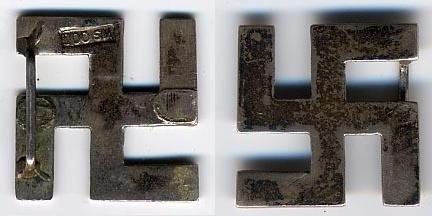
 0
0 -
Of course there are
 Here's one I've been told is an early type. Possibly a St.&L. ?
Here's one I've been told is an early type. Possibly a St.&L. ?KR
Peter
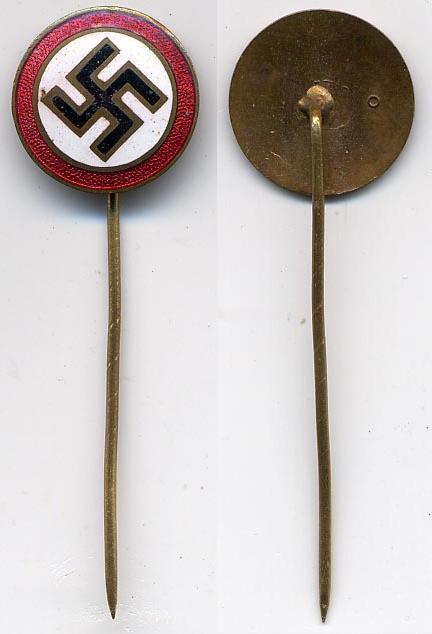
 0
0 -
Hi David,
A court-order was instituted in 1744, when Crown-Prince Adolf Fredrik married the Preussian princess Lovisa Ulrika and was named "l'ordre de l'harmonie", (solar-fan Order). In 1748, the first three Knight Orders were instituted by Fredrik I i.e. Seraphimer (highest ranking Order
 ), Sword and North Star. The Seraphimer was given to foreign kings and princes, or Swedish civil servants who had distinguished themselves. The Order of the Sword was a purely military order.
), Sword and North Star. The Seraphimer was given to foreign kings and princes, or Swedish civil servants who had distinguished themselves. The Order of the Sword was a purely military order. Now to the question starting this thread. The statues of the Order of the North Star stipulates roughly: honest, renowed and loyal men of the King and servants who through brilliance and useful work, new and favourable appliances etc. Consequently this order was mainly intended for scientists or civil servants. In 1771, Gustav III instituted the Order of Vasa. It's statues has already been accounted for here, but it also opened up for the possibility to award others than just scientists or civil servants.
KR
Peter
0 -
A lot of guys built the Titanic and it went all the way down


KR
Peter
0 -
Thanks Gordon,
The abovementioned type of KVK was actually on of the reasons for my inquiry. I'm still not clear about some aspects, but I'll stand down for the time being and see if I can figure out a way to put words to these complex questions.
KR
Peter
0 -
It's difficult to judge from these images, but shouldn't the lower cut-outs on the wreath be visible from the reverse, considering the angle presented?
KR
Peter
0 -
0
-
Bringing this one back to the top.
KR
Peter
0 -
Hi Gordon,
Thanks for a very informative thread. However there are still a couple of things that are not clear to me and perhaps you can help me out.
I hadn't seen any info on when the Lieferanten-Nummer (commonly known as PK-number) came into existence, until I read about in Frank's book and I quote:
".... the by-law of 1st July 1937 designated Hitler as the sole authority in bestowing official decorations and awards. From here on, the Präsidentialkanzlei des Führers, and it's subsidiary branch, the Ordenskanzlei, exercised strict control over the creation and production of decorations, and selected the various companies that would be awarded goverment contracts. Located in Berlin, this institution was led by Ministerialdirektor Dr. Heinrich Doehle. Manufacturers, after being chosen for the production of actual award pieces, were assigned a Lieferanten-Nummer."
Next quote:
"In Juli 1940, the Leistungsgemeinschaft Deutscher Ordenhersteller more commonly known as "LDO", was founded and put under the direction of its general manager and NSDAP member, Schürmann."
Is it fair to assume that 1937 was the actual date for the introduction of the PK numbers? Also, the control of official awards was conducted by the Ordenskanzlei, led by Doehle, but was the LDO a sub-branch to the Ordenskanzlei, thus giving him superiority over Sch?rmann?
Is it known what date Otto Schickle's license was revoked?
In St.&L.'s add from 1941, the articles Dienstauszeichnungen der NSDAP, verkleinerungen, anstecksnadeln, decorationen etc are mentioned. A recent thread on this forum featured a NSDAP LS miniature with the RZM number M11/1, which should be correct for NSDAP LS decorations. When was the sub-group M12/... founded (NSDAP LS miniatures). I know that RZM numbers are a totally different ballgame, but it would be interesting to know, especially since I can't find St.&L. amongst the M12 firms in any reference book.
KR
Peter
0 -
Here's a heavily vaulted cross with four rivets, 30's manufacture?
KR
Peter



 0
0 -
Hi Kev,
That's utter rubbish and I guess the main component is led. The hinge is typical for these poor fakes.
KR
Peter
0 -
I made some searches on the Internet and come up with interesting info (with reservation for my poor German
 ).
).The first Kriegerbund was formed in 1786 by F?silliere Fredrich des Grossen in Wangerin/Pommern. Several followed, but not until the conflicts in 1864, 1866 and 1871 did they expand significantly. In 1873 was the Deutscher Kriegerbund formed by the dominating Preussischen Landesverband, leaving the remaining Landesverbanden (Bayern, Sachsen, W?rttenburg, Hessen and Baden) independent. So far Wikipedia.
The earlier "St?ndige Ausschuss der Deutschen Landes-Krieger-Verb?nde f?r die Verwaltung des Keiser Wilhelm Denkmals auf dem Kyffh?user" adopted the new name "Kyffh?user-Bund der Deutschen Landes-Krieger-Verb?nde" in 1900 and by that became the central organisation for all Landesverbande. In 1922 yet another name was adopted "Deutscher Reich-Krieger-Bund Kyffh?user".
In 1912 there were 27 Landesverb?nde with 31.004 branches totalling 2.746.505 members.
Well. I'm struggling with my German, so here's a link

http://www.smvb.de/organisation/kueff_3.html
KR
Peter
0 -
I'm not quite clear about this topic, but I'll give it a try.
The two first crosses presented are from Preussischer Landeskriegerverband (Preussian War Veteran Organisation) and I don't believe this type is the one cited on the document. As stated, there were a couple of other decorations of similar design i.g. the war veteran organisations of Anhalt, L?beck, Hessen etc. I assume the Deutscher Reichkriegerbund "Kyffh?user" (Deutsche Landeskriegerverbande) was some sort of umbrella for the individual states, perhaps even on state level. The oval medal is referred to as Kriegsdenkm?ntze 1914-18.
Something happened in the early 30's and the wearing of decorations from the various veteran organisations was banned. I'm interested to know the full story about this event, because there are at least three organisations that had the swastika incortorated in their medals i.e. Reichtreuebund ehemaliger Berufsoldaten (RTB), Deutscher Reichkriegerbund Kyffh?user (DRKB) and NS-Reichkriegerbund (NSRKB). The latter seems more probable as the "end product", but the late date on the document (1936) indicates the DRKB was still in existence. Any thoughts?
KR
Peter
0 -
Paul, I bet you've never seen this one before

KR
Peter
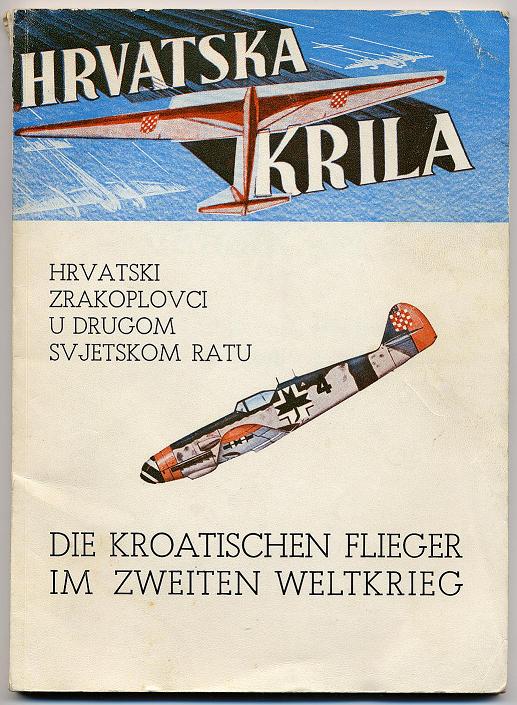
 0
0 -
Don, I believe the correct marking should read "Entw.Fec.O.Placzek.Berlin". Entwurf in German is scetch or outline

Nick, thanks for posting this pin. The lack of the lower cut-outs and the different position of the maker's mark suggests at least two different dies. The pin is a dead-ringer though. Is there some sort of lacquer present?
KR
Peter
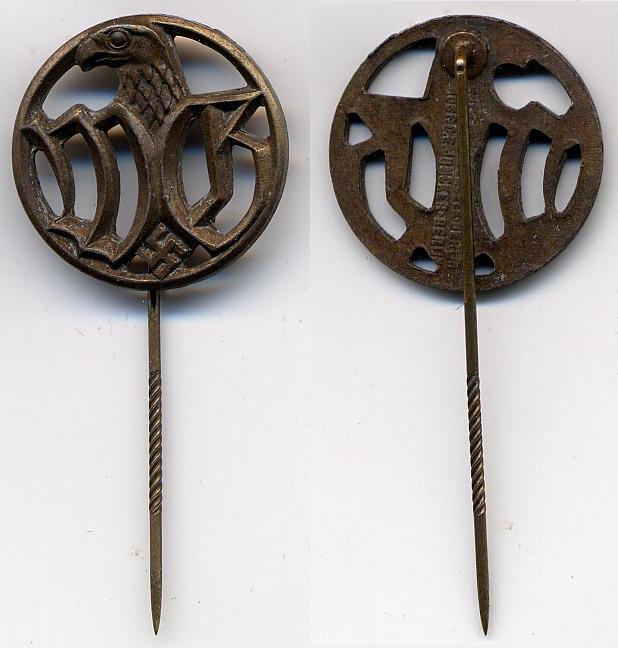 0
0 -
Rick, I'm equally embarassed, it was right under our noses all the time
 . BUT, the document in Angolia's book doesn't make sense to me. The fact that it's a hybrid of the documents in post #30 and #32 can possibly be explained, but how can a 19 year old guy qualify for a silver version, unless he made his first test at the age of 11? Or am I missing something essential
. BUT, the document in Angolia's book doesn't make sense to me. The fact that it's a hybrid of the documents in post #30 and #32 can possibly be explained, but how can a 19 year old guy qualify for a silver version, unless he made his first test at the age of 11? Or am I missing something essential 
Uwe, hats off for you

KR
Peter
0 -
Uwe, have you noticed the document on page 236 in Angolia's "For F?hrer ..." , 2nd vol.?
KR
Peter
0 -
This statement was brought to our attention on WAF a while back, with little or nothing in response. I'm certain Uwe will fill us in on the details, but as far as I'm concerned I find it very plausible, regardless of what all publications will tell us.
KR
Peter
0 -
Chris, that's interesting
 . Please let me know, should you find the book.
. Please let me know, should you find the book.KR
Peter
0 -
2nd image
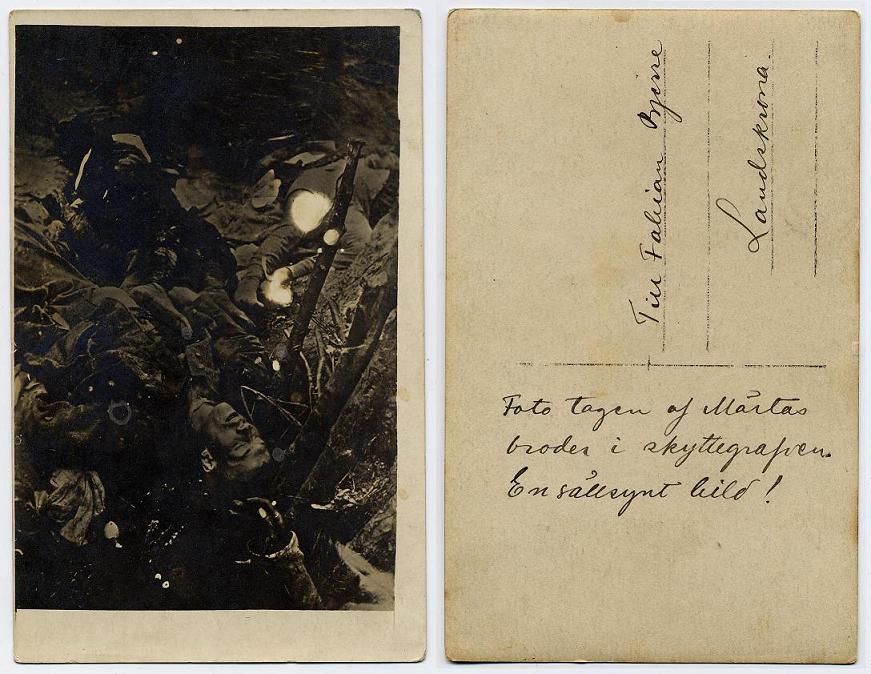
 0
0 -
reverse
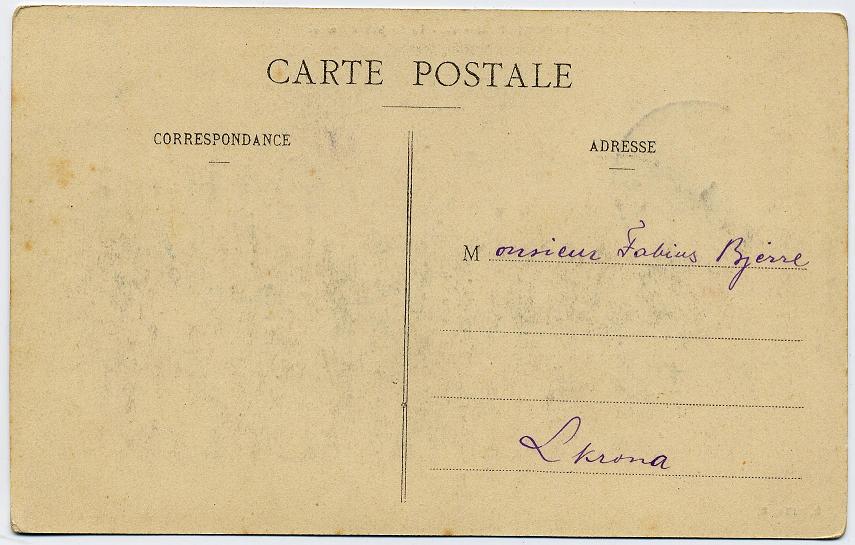
 0
0 -
The French Foreign Legion is an unknown chapter for me, but today I was told a story I would like to share with you guys. An acquaintance of mine told the story of his grandmother's brother, who served in the Legion from 1910-1913 in Morocco. He was also kind enough to lend me a couple of photos for your weiwing pleasure.
Verner Nilsson went down to North Africa in 1910 and served in the Legion for 2 1/2 years, under the name of Verner Nelson. By reading his correspondence to Sweden (I looked through some 30 postcards), it's evident he saw some heavy fighting. In 1913 he had enough and swam out to a Swedish vessel outside Casablanca, which brought him back to Sweden. Once back home, he found God and travelled around the Swedish countryside in his uniform, giving lectures about his years in the Legion. He also wrote a book titled "Two and a half years in the Foreign Legion". I've tried to find something about this book on the web, but still no luck. The uniform was hanging in the attic for many years, but was eventually thrown away along with the book
 .
.The 1st postcard is a wiew of La Casbah d'Isma?l. I tried this on the web as well, but French is a sound I don't comprehend (sorry Chris
 ). The most fascinating thing is the address, the name and Lkrona, which is short for Landskrona. That surely wouldn't work today.
). The most fascinating thing is the address, the name and Lkrona, which is short for Landskrona. That surely wouldn't work today.The 2nd image needs no explaination, but the wording on the back is a killer, "Photo taken on M?rta's brother in the trench"!!!
KR
Peter
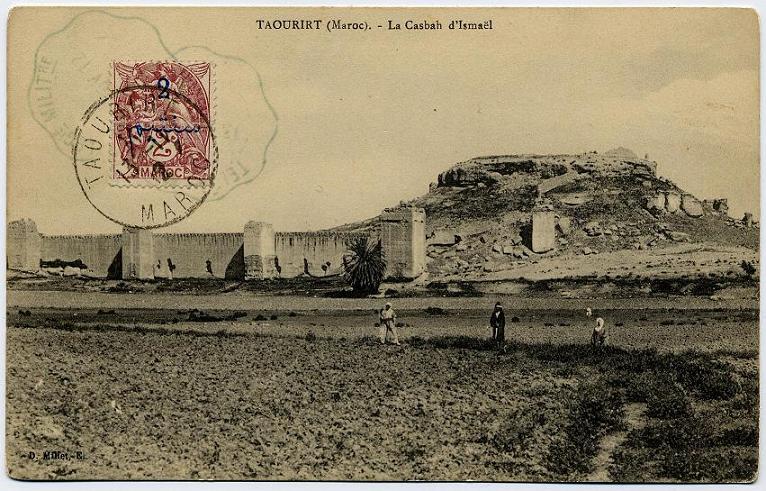
 0
0




Widow Cross with screwdisc
in Germany: Imperial: The Orders, Decorations and Medals of The Imperial German States
Posted · Edited by Peter J
Thanks Rick. Perhaps I should emphasize that I don't have any reservations about the design or appearence of this type of decoration, only the fact that it's a widow-cross. The cross with or w/o swords could of course be worn on the lapel of a jacket. However, female garments rarely featured these lapels, leaving the more likely option of wearing it directly on the chest. I can accept this from a male, but having a slight insight in the female character, I doubt any woman would ruin her garment by punching a big hole in it, in order to attach the screw-disk. Just my two cents
In addition to Tom's response, this cross was awarded to woman.
P.S. Is the cross shown here a normal size cross or a half-miniature (31mm)? D.S.
KR
Peter